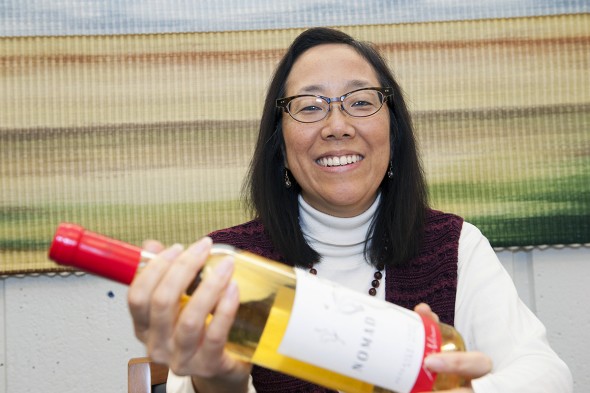Helping Romanian wine make a name for itself

Business professor Cheryl Nakata traveled to Romania to make recommendations for improving its winemaking industry. “There’s a difference between a $5,000 bottle of wine and a $5 bottle,” she says. “It has a lot to do with the people who make it and where the grapes are grown.” Photo: Roberta Dupuis-Devlin/UIC Photo Services
Romania is one of the world’s leading producers of wine, but you’ve probably never tasted any.
That’s likely to change, says Cheryl Nakata, professor of marketing and international business and head of managerial studies in the College of Business Administration.
A couple of summers ago, she visited the eastern European country to study its winemaking industry and make recommendations for improvement.
The main reason no Romanian vintages are on the shelf at your liquor store: about 90 percent of Romanian wine is consumed domestically, Nakata said.
In other words, Romanians — many of whom make their own wine at home — drink the vast majority of their country’s wine.
Much of the remainder is shipped as raw material to Germany and other countries to be mixed with their wine.
Thus, although Romania is the 12th largest producer of wine in the world, Nakata said, very little of the stuff is sold outside its borders.
Accompanied on her research visit by Romanian-American UIC student Otilia Flandro — who acted as interpreter and chronicled the trip as an Honors College project — Nakata interviewed 13 managers and owners of seven wine companies, plus five Romanian wine industry experts.
She found that “the largest producers largely ignore the international market because they have a lock on the domestic market.”
“They’re picking the low-hanging fruit, or grapes.”
But more far-sighted producers want to export their product.
“This is, in part, a desire for legitimacy,” Nakata said. “If you take pride in your work, you want others to recognize it as exceptional, too.”
Romanian wines are often compared to those produced in the French region of Bordeaux; the Dealu Mare region in Romania is at the same latitude.
The Romanian wine producers use native grapes, “or they mix these with French grapes — take Cabernet Sauvignon and mix it with Feteasca Neagra,” Nakata explained.
Of the barriers to export, the biggest is cultural.
A bottle of wine is synonymous with the region where it is produced, she said.
“With California, you think about sunshine, open land, something that’s hip and modern and young.”
But Romania has what Nakata calls an “image liability.”
“Romania is part of the European Union, but not a welcome member,” Nakata said.
“There’s an east-west divide. Western Europe has economic and cultural dominance. If you’re in Eastern Europe, you feel a step below and a century behind.
“Western Europeans think of Ceausescu, who ruled as an autocrat for decades [until 1989] — of a country that’s poor and backward, politically and economically unstable. They also think of the Gypsies, or Romas, a nomadic culture that spread across Europe and is perceived by some as criminal and backward,” she said.
“It makes for an intriguing marketing challenge.”
Another barrier to export is cost.
“Romania can’t make wine of high quality and low production cost,” Nakata said.
“Their vineyards are small, so they don’t have economies of scale, they don’t have the same technology [as competing winemakers], and the cost of labor is high.”
Experts from Australia, France and the U.S. are teaching the country’s winemakers how to grow grapes and blend wines, she said.
Romanians were making wine before the Romans, but it was all forgotten during 50 years of communism.
“A whole generation of wine knowledge was lost,” Nakata said. “They made whatever was sweet and cheap, and added sugar to mask imperfections.”
Nakata was born in California and raised in Hawaii. She earned a bachelor’s degree at the University of Hawaii at Manoa and an MBA at Northwestern University.
She worked in market research for Kraft and General Mills before moving to China to work in an international joint venture. Returning to Chicago, she started a marketing consultancy for international business and enrolled in UIC’s doctoral program in marketing and international business. She joined the faculty after finishing her Ph.D. in 1997.
“The wine industry is intrinsically fascinating,” said Nakata, who lives in Chicago’s Logan Square neighborhood.
“It epitomizes all of the tensions of globalization, married to the fact of wine as a physical product.
“Grape juice is grape juice, but there’s a difference between a $5,000 bottle of wine and a $5 bottle. It has a lot to do with the people who make it and where the grapes are grown.
“Look out for Romanian wines,” she said.
“Maybe they’ll be the next big hit, like Australian or Chilean wines.”
